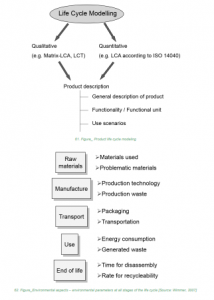Lesson 8: Some of the simplified life cycle assessment methods
In this lesson, we will explore some of the simplified Life Cycle Assessment (LCA) methods that provide a basic understanding of a product’s environmental impact and facilitate initial evaluations.
- Qualitative Assessment of the Product (Description)
Introduction:
- Qualitative data uses rating scales, such as 1 (BEST) to 5 (WORST), or relative ratings like “BETTER THAN” or “WORSE THAN.”
- Qualitative data can describe various aspects of the product, including its name, components, functionality, and functional unit.
- It can also include a textual description of the product.
Environmental Parameters:
- To assess the environmental dimension of a product using qualitative data, we consider “environmental parameters.”
- It is crucial to define the boundaries of the system to assess environmental impacts accurately.
- MET-MATRIX (Environmental Impact Evaluation)
Overview of the MET-MATRIX:
- The MET-MATRIX (Material – Energy – Toxicity) is a simple qualitative method for evaluating a product’s environmental impact.
- It provides an initial understanding of the environmental impact at different life cycle stages and identifies significant stages.
Combination of Parameters:
- Environmental impact assessment requires a combination of different parameters, such as energy consumption, material usage, and non-renewable resource consumption.
- For toxic substances, even small amounts can have a significant impact.
Identifying “Hot Spots”:
- The MET-MATRIX is valuable for identifying “HOT SPOTS,” both qualitatively and quantitatively.
- It offers suggestions for areas that require further evaluation and improvement.
- ECODESIGN WEB
Introduction to ECODESIGN WEB:
- ECODESIGN WEB is like a visual checklist for quick design evaluation.
- It aids in assessing various design aspects with environmental considerations.
- Ecological Footprint
Understanding Ecological Footprint:
- The ecological footprint quantifies the environmental impact of human activities based on land use.
- It calculates how much biologically productive land is needed to support human consumption.
- Some regions exceed Earth’s capacity, indicating unsustainable practices.
Regional and Product-Specific Calculations:
- Ecological footprints can be calculated for specific regions and products or product systems.
- Ecological Rucksack
Definition of Ecological Rucksack:
- The ecological rucksack represents the environmental burden associated with a product.
- It calculates the total quantity of natural materials disturbed or used to create a product, excluding the product’s weight.
- Materials are categorized into abiotic, biotic, water, and air.
Comparing Products:
- Ecological rucksack calculations make it easy to compare products and assess their environmental burdens.
- MIPS – Material Intensity per Unit of Service
Connection to Ecological Rucksack:
- MIPS is closely related to the ecological rucksack.
- It calculates the material intensity of a product per unit of service it provides during its lifespan.
- For instance, the ecological rucksack can be calculated for all car components (Material Intensity or MI), while MIPS divides MI by the expected kilometers traveled or product lifespan.
Relating to Functional Units:
- MIPS is connected to functional units in LCA but provides a more specific evaluation.

Conclusion:
In conclusion, these simplified Life Cycle Assessment (LCA) methods and tools provide valuable insights into a product’s environmental impact, making it easier to initiate sustainable design practices. Here are three key takeaways from this lesson:
- Qualitative Assessment: Qualitative data and descriptions offer a foundational understanding of a product’s environmental aspects, enabling initial evaluations and discussions in the design process.
- MET-MATRIX and Hot Spots: The MET-MATRIX helps identify “hot spots” in a product’s life cycle, allowing designers to focus their efforts on areas with the most significant environmental impacts.
- Ecological Footprint and MIPS: Concepts like the ecological footprint and MIPS offer quantifiable measures for assessing resource usage and material intensity per unit of service, aiding in product comparisons and environmentally conscious design decisions.
By integrating these simplified LCA methods and tools into the product development process, designers and stakeholders can make informed choices that contribute to more sustainable and eco-friendly products.